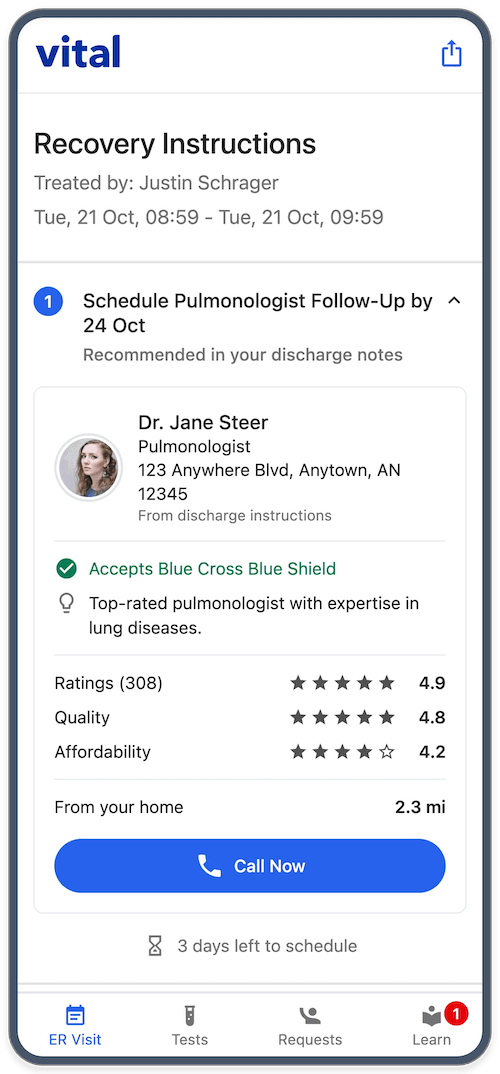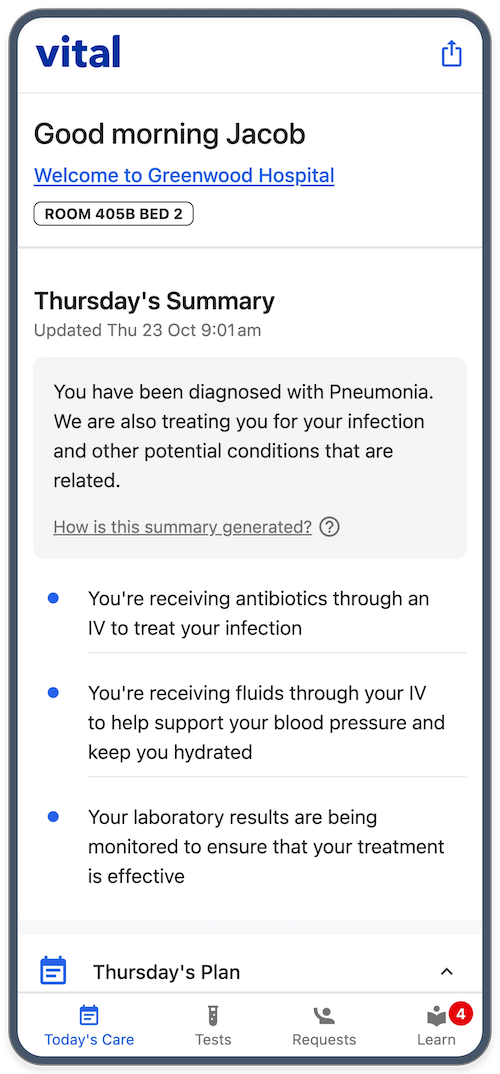
Function
Vital Inpatient engages patients & families in between rounds
By tapping into real-time EHR data, Vital provides personalized guidance during inpatient stays
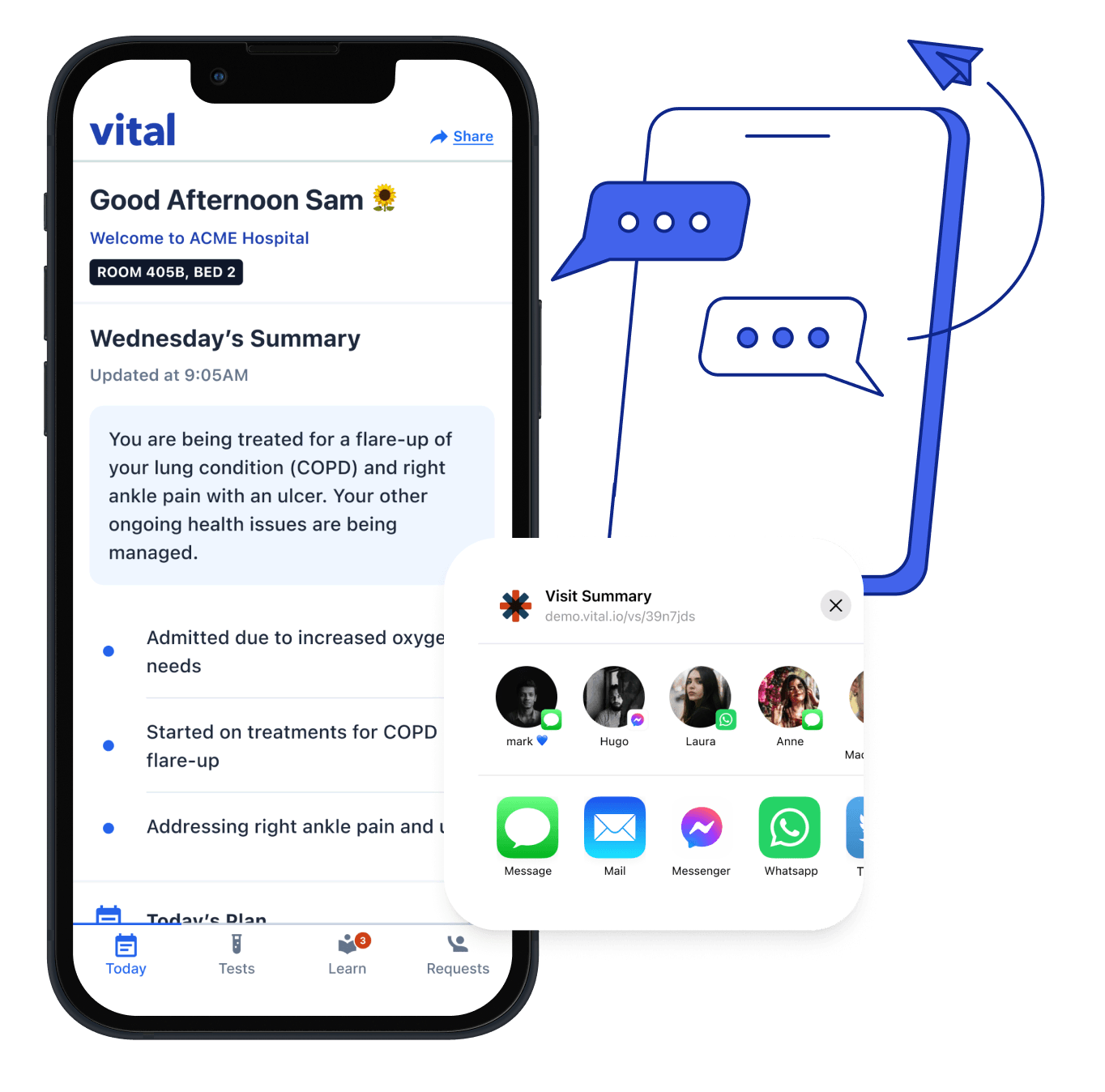
Vital Inpatient engages patients & families in between rounds
By tapping into real-time EHR data, Vital provides personalized guidance during inpatient stays. AI explains test results in plain language, assigns education, and helps patients take control of their care.
Vital Inpatient is a no-downloads, no-account-required mobile app that gives patients the understanding, mobility, and interactivity they need during a hospital stay. Patients can engage with their goals, track progress, order meals and request service, understand test and imaging results, view patient education, keep family members informed, and more.
The result is better patient engagement between rounds. That leads to lower length-of-stay, lower 30-day readmissions, and increased HCAHPS scores.

The patient engagement layer of your EHR
Vital sits on top of your EHR (e.g., Cerner, EPIC, etc.,) using a FHIR or HL7 interface to give patients a live view of what’s happening behind-the-scenes. When a patient is first roomed, they receive an SMS text message invite with a special link, unique to each patient. There’s no app to download or password required.
By making it simple and secure, 50%+ of patients use Vital Inpatient during an inpatient stay. By making it easy, we ensure a high level of utilization by patients of all ages.
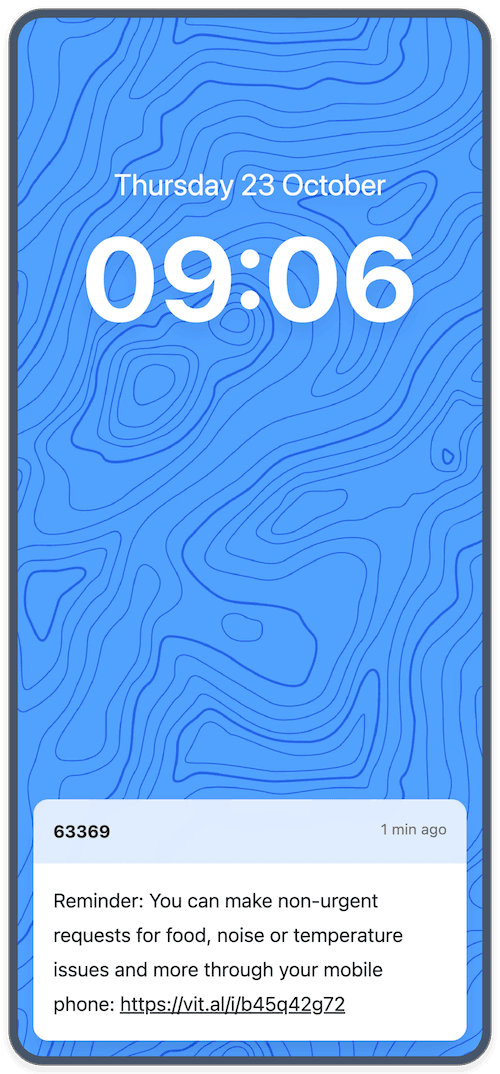
An "AI whiteboard"
Vital’s Care Summary is a personalized approach to the patient care timeline. Think of it as a digital whiteboard that automatically writes itself. Patients - and family - see clinical status updates, a truly personalized care plan, dietary restrictions and inpatient goals.
A patient's Care Summary is updated automatically using advanced AI throughout the day, saving time for nursing staff. Behind the scenes, the system monitors for changes in consult notes, progress reports, and even occupational or physical therapy progress, along with upcoming orders.
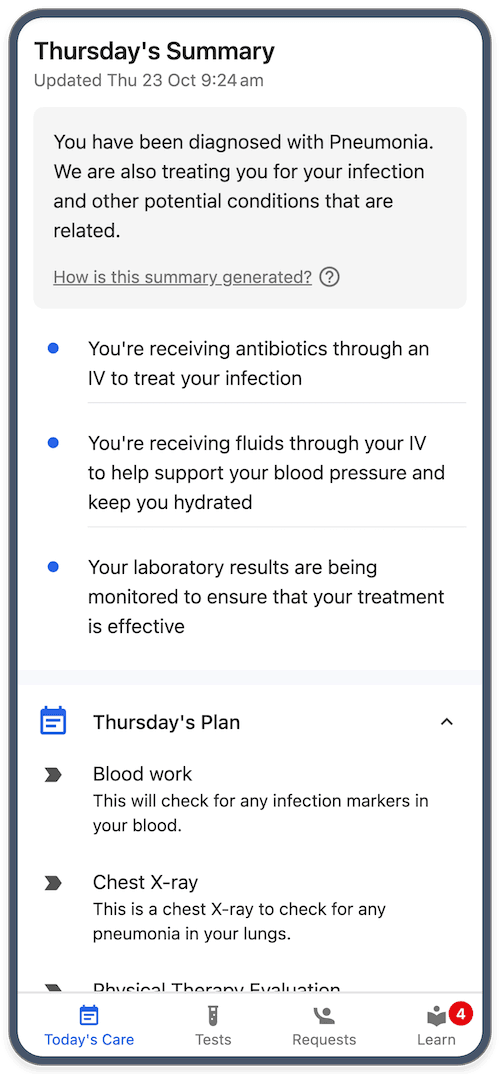
A look at the day ahead
Vital prepares patients and family for each day with a timeline of care. That includes preparing for upcoming procedures, placing food orders, and adhering to care team instructions (e.g., “No food or drink after midnight.”)
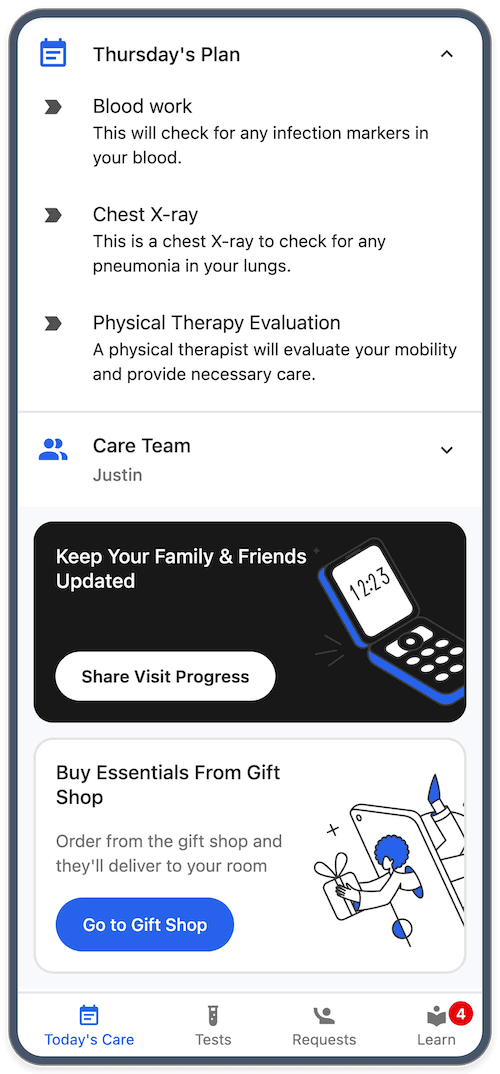
Real-time service requests & service recovery
Patients can request items (e.g., food, phone charger, etc.) and services (e.g. room cleaning, pet therapy, etc.) with just a few taps.
Request are routed to the appropriate department (e.g., Food & Nutrition, Environmental Services, etc.). This reduces burden for floor nurses so they can do what they do best — care for patients.
Requests are programmable, and request types can vary by location. For example, lactation consultation is limited to the maternity ward while toy requests to be available in pediatrics.
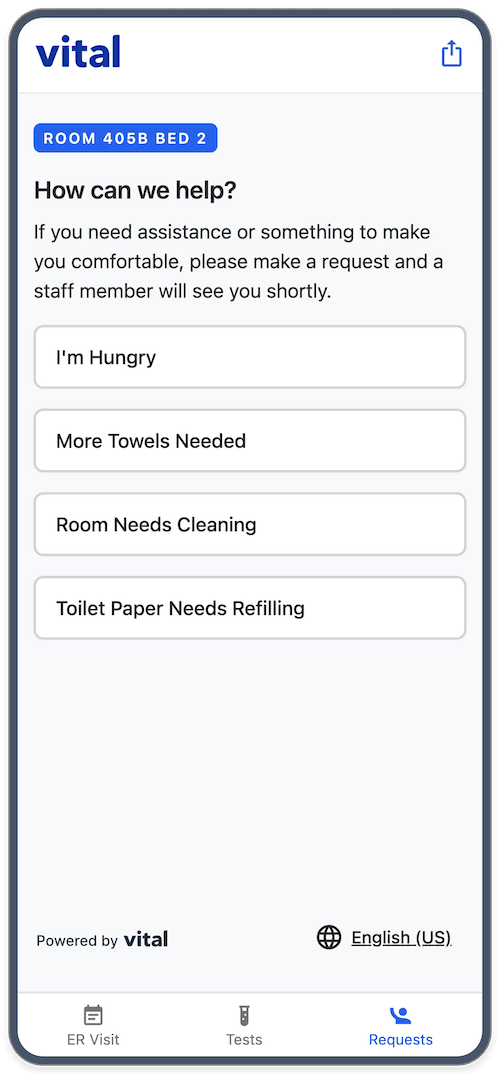
Always up-to-date education
Nurses want to keep patient education relevant. But ordering it can take time. That’s where Vital’s AI comes in. Vital looks at upcoming orders to determine the most important education for each patient right at a given time. Pre-surgery? It’s likely procedure preparation. Post-surgery? A video on how to recover.
Vital’s AI automatically creates a custom list of videos and content, reducing manual steps.
By default, Vital uses multi-lingual ViewMedica videos and content from MedlinePlus. AI-generated mappings for major content providers like Krames, Elsevier, Healthwise, and Emmi are also available.
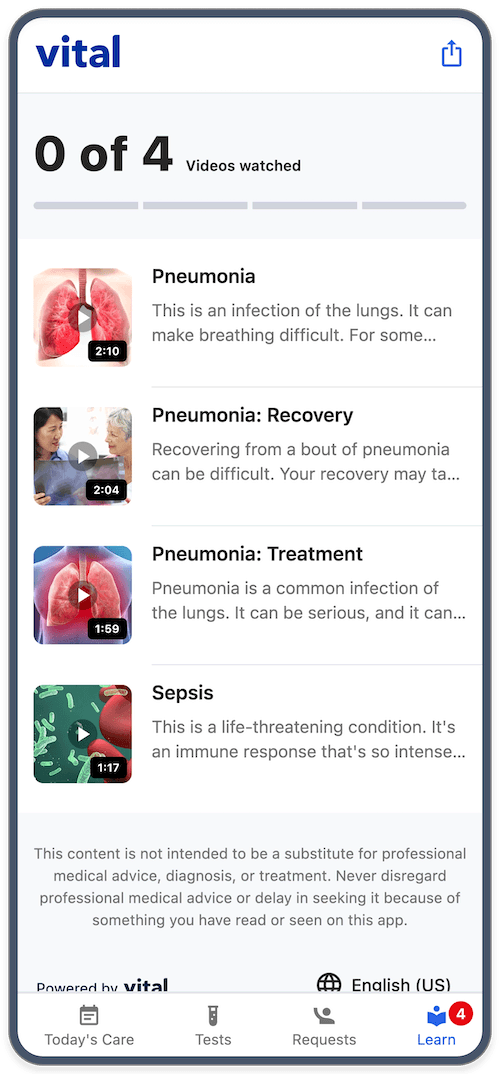
Patient-friendly test results with “sensitive” filters
At Vital, we believe that lab results should be more accessible and understandable. Instead of presenting results as chemical symbols with little context, we provide clear, meaningful descriptions for all common test components, making it easier for everyone to understand their results.
Videos for common labs include Complete Blood Count, or Understanding a CT Scan with Contrast.
We have 2,000 pages of content in English & Spanish tied to LOINC-level codes.
Hospitals can choose to delay abnormal or critical results. For example, “normal” results are usually released immediately, “abnormal” with a 30-60 minute delay, and “critical” results like cancer or loss of pregnancy may be omitted entirely.
Generative AI to improve patient understanding
Radiology reports often present complex terminology that can be confusing for patients. While terms like "subluxation of the posterior talar fragment" may be clear to medical professionals, patients might struggle to understand them. Vital employs advanced generative AI in its innovative doctor-to-patient translator to convert medical jargon into clear, comprehensible language. By providing patients with understandable information, Vital empowers them to ask more relevant questions and enhances their adherence to care plans.
Try it yourself or see the launch at the Ai4 conference.
Secure family sharing
Patient health — and readmission avoidance — relies heavily on family and caregiver involvement. That’s why Vital builds sharing features into its products. Family members can see patient education, review the day’s timeline of care, and understand how they can help with the transition back home.
Patients can share their visit securely in the same way they already share photos, videos, or articles today.
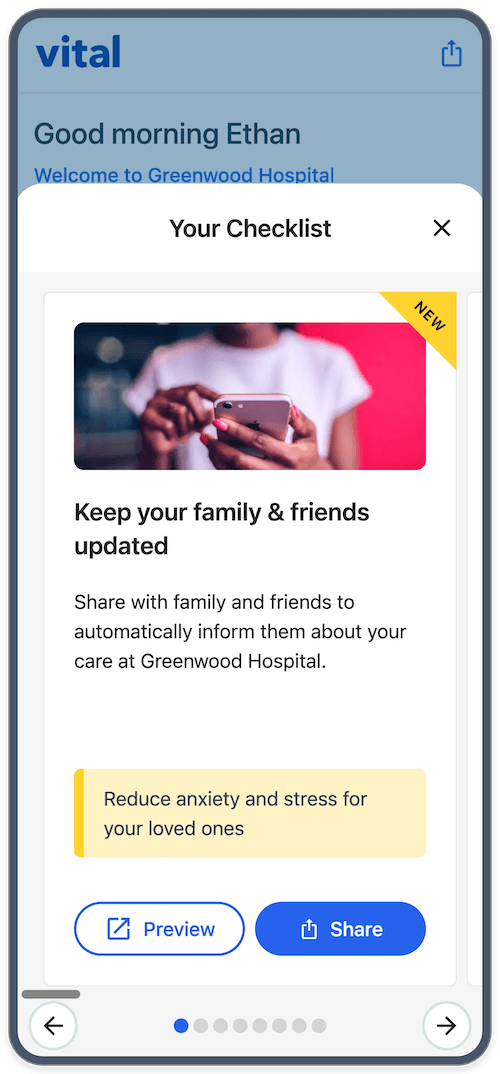
Discharge instructions that patients are motivated to follow
Many patients find it challenging to read through the 10-15 pages of discharge instructions they receive, and a significant portion may end up discarded.
Vital uses AI to parse discharge instructions into a 1-2-3 step checklist.
Vital summarizes the “to-do list” in discharge instructions for higher adherence to plan, resulting in lower readmissions and better health outcomes. This includes:
An AI summary of their medical plan & assessment.
Follow-up appointments with due dates for each.
A list of new medications, which pharmacy they were sent to, and pharmacy hours + directions.
Tertiary task list: sign-up for the patient portal, give a nurse compliment, and watch videos on diagnoses.
